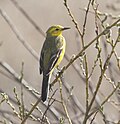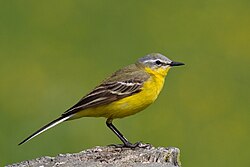| Image | Scientific name | Common name | Distribution | Characteristics |
|---|

Northumberland, UK | M. f. flavissima
(Blyth, 1834) | Yellow wagtail | Breeding: England, east Wales, southeast Scotland; occasionally on adjacent European coasts. Winter: West Africa, mostly Senegal, Gambia. | Yellow-green head with a brighter yellow supercilium. Females markedly paler below than males. |

Bashkortostan, Russia | M. f. lutea
(S. G. Gmelin, 1774) | Yellow-headed wagtail | Breeding: Lower Volga to Irtysh River and Lake Zaysan. Winter: Africa and Indian subcontinent. | Head yellow with green neck in males, females like a somewhat more vivid M. f. flava female. |

Arnhem, Netherlands | M. f. flava
Linnaeus, 1758 | Blue-headed wagtail | Breeding: southern Scandinavia (and occasionally on the east coast of Great Britain) to France and central European mountain ranges, east to the Urals. Winter: sub-Saharan Africa. | Blue-grey head with white supercilium and malar stripe in males, much washed with dull green in females. |

Tyumen, Russia | M. f. beema
(Sykes, 1832) | Sykes's wagtail | Breeding: North of M. f. lutea, east to Ladakh area. Winter: Indian subcontinent, also east Africa and adjacent Arabia. | Like M. f. flava but head lighter grey, ears washed white; females probably indistinguishable from female M. f. flava. |

Barcelona, Spain | M. f. iberiae
Hartert, 1921 | Spanish wagtail | Breeding: south-western France, Iberia, Maghreb from Tunisia to Banc d'Arguin. Winter: The Gambia to the Central African Republic. | Like M. f. flava, but throat white and grey darker, almost black behind eyes. |

Tuscany, Italy | M. f. cinereocapilla
Savi, 1831 | Ashy-headed wagtail | Breeding: south-eastern France, Sicily, Sardinia, Italy, Slovenia. Winter: coastal Tunisia and Algeria, Mali to Lake Chad. | Like M. f. iberiae but supercilium absent or vestigial. |
| M. f. pygmaea
(A. E. Brehm1854), | Egyptian yellow wagtail | Nile Delta and lower Nile; resident, non-migratory. | Similar to M. f. cinereocapilla, but smaller, less bright. |

Penza Oblast, Russia | M. f. leucocephala
(Przevalski, 1887) | White-headed wagtail | Breeding: north-west Mongolia and adjacent China and Russia. Winter: probably India. | Male like flava, but grey of head very pale, almost white. Female like M. f. flava females, but head somewhat darker. |

Kurdistan, Turkey | M. f. feldegg
Michahelles, 1830 | Black-headed wagtail | Breeding: Balkans east to the Caspian Sea, south to Turkey, Iran and Afghanistan; also Levant. Winter: central Africa from Nigeria to Uganda and south Sudan, and east to northern India. | Jet black cap in males, females like a dull M. f. thunbergi male above, washed-out dirty yellowish below, throat white. |

Oppdal, Norway | M. f. thunbergi
Billberg, 1828 | Grey-headed wagtail | Breeding: central and northern Scandinavia east to north-west Siberia. Winter: eastern Africa, Indian subcontinent, Southeast Asia. | Head dark grey, reaching down to the cheeks, and without white in males; lighter and washed greenish, with vestigial greenish supercilium in females. |
|















